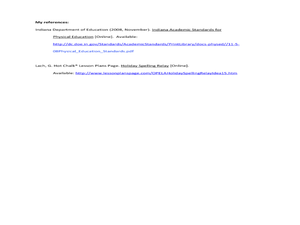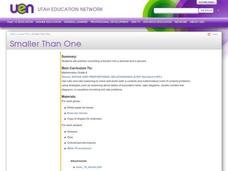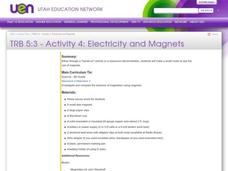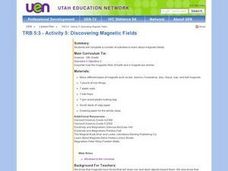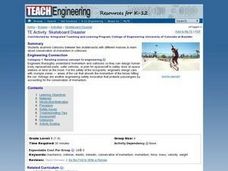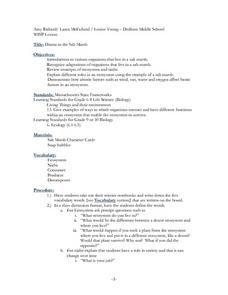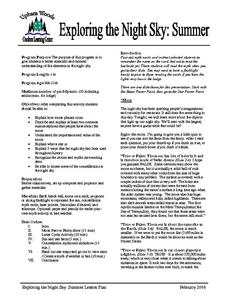Curated OER
Clothing-Based Bias
Young scholars investigate stereotypes attached to clothing. In this teaching tolerance activity students explore how the way someone dresses can influence other people's perception of that person. Young scholars discuss what groups of...
Curated OER
Interdisciplinary Lesson Plan
Third graders study Thanksgiving. In this physical education and spelling lesson, 3rd graders play a race game by being the first group who can spell the word Thanksgiving first.
Curated OER
States and Capitols Match-Up
Fifth graders should have been introduced to the fifty states already before completing this activity. Different groups of students focus on different regions of the country and their capitols. They change regions throughout the activity.
Curated OER
Check My Writing: Diversity of Learners Adaptation
Students explore different spellings of the same words within the English language, as well as different words for the same thing with the international pen pal classroom. They become familiar with units of measure and time. Students...
Curated OER
May the Force Be With You
Students work in groups, they investigate how different forces act upon objects and how this information can be used in their day-to-day lives. They wrap the rubber band around the book. Students place the bo.ok and ruler on top of a...
Curated OER
New Way to Produce Biofuels
Students identify global issues in the world today. They explore the vocabulary related to the issues and design a poster for a campaign to deal with one of the global issues they identified. Worksheet and answer key provided.
Curated OER
Shake, Rattle and Roll
Sixth graders explore the causes and effects of earthquakes. They also collect and analyze data in graphs. They also use the Internet to research earthquakes
Curated OER
Smaller Than One
Sixth graders practice converting a fraction into a decimal and a percent. They explain relationships among rational numbers. They order and compare whole numbers, fractions (including mixed numbers), and decimals using a variety of...
Curated OER
The Death Penalty
Students examine the controversy surrounding the death penalty. In this capital punishment lesson, students explore the ethical concerns and religious beliefs regarding the death penalty. Students conduct research, interview people, and...
Curated OER
The Death Penalty
Students examine the controversy surrounding the death penalty in the United States. In this current events instructional activity, students research the history of the death penalty as well perspectives on the topic. Students interview...
Curated OER
Introduction to Reform Movements of the 1800s
Eleventh graders consider the impact of reform movements of the 19th century. In this Progressive Reform lesson plan, 11th graders examine documents and images associated with women's suffrage, prohibition, and labor reform. Students...
Curated OER
Orienteering Scavenger Hunt
Students take a reading with a compass and use the compass to reach multiple checkpoints in a scavenger hunt activity.
Curated OER
Electricity and Magnets
Fifth graders find examples of magnets in or around their homes and make a list. They discover that some motors use magnets and make a simple motor using magnets, a battery and copper wire. They add to their magnet list.
Curated OER
Discovering Magnetic Fields
Fifth graders examine the different types of magnets (bar, horseshoe, disc, ball, etc.) and experiment with the magnets and iron filings to discover the magnetic fields of each type of magnet.
Curated OER
A Field of Beans
Beans, or legumes as they are sometimes called, are the topic for an integrated multi-subject lesson. Youngsters will read, write, observe, and research everything there is to know about beans. They read a bean story, conduct a bean...
Curated OER
Skateboard Disaster
Learners conduct a hands-on experiment with collisions between two skateboards of different masses. They are introduced to the concept of conservation of momentum in collisions and consider how their observations might help engineers...
Curated OER
Drama in the Salt Marsh
Learners are introduced to the various organisms that live in a salt marsh. They recognize adaptations of organisms that live in the salt marsh. Pupils review concepts of the ecosystem and niche. Students explain the different roles...
Curated OER
Salinity
Students take a provided ocean Trivia Quiz in order to start a discussion of the ocean. They then perform an experiment on how the amount of salt in the ocean affects it and varies from ocean to ocean.
Curated OER
Exploring the Night Sky: Summer
Students explain how moon phases occur. They describe and explain at least two common misconceptions that people have about the moon. Students explain what a star is. They explain 3 ways that the night sky has been used throughout history.
Curated OER
Finding Synonyms
Student identify synonyms in poetry. In this grammar lesson, students define what a synonym is and view several examples on the board. Students read a selected poem on an overhead transparency and circle the synonyms.
Curated OER
Maxima and Minima Problems
Students calculate the maxima and minima of quadratic equations. In this calculus lesson plan, students apply the derivatives by finding the maxima and minima using real life application. They solve optimization using the derivative.
Curated OER
Staghorn Coral
Students recognize that staghorn coral helps reef growth in the Caribbean. In this Coral Reef lesson, students design a habitat model using various art materials to explain how staghorn coral helps the reef grow. Students share...
Curated OER
Pop Rocket - Trash to Treasure
First off, Newton's laws of motion aren't often taught at 2nd grade, so this lesson may be more appropriate for upper elementary learners. It begins with a discussion and demonstration of the laws of motion, and then has individuals...
Curated OER
Static Electricity 1: Introducing Atoms
Students explore webpages to research the nature of atoms, including electrons, protons, and neutrons. This lesson is the first of a four-part series on static electricity. They see that static electricity involves + and - charges.



